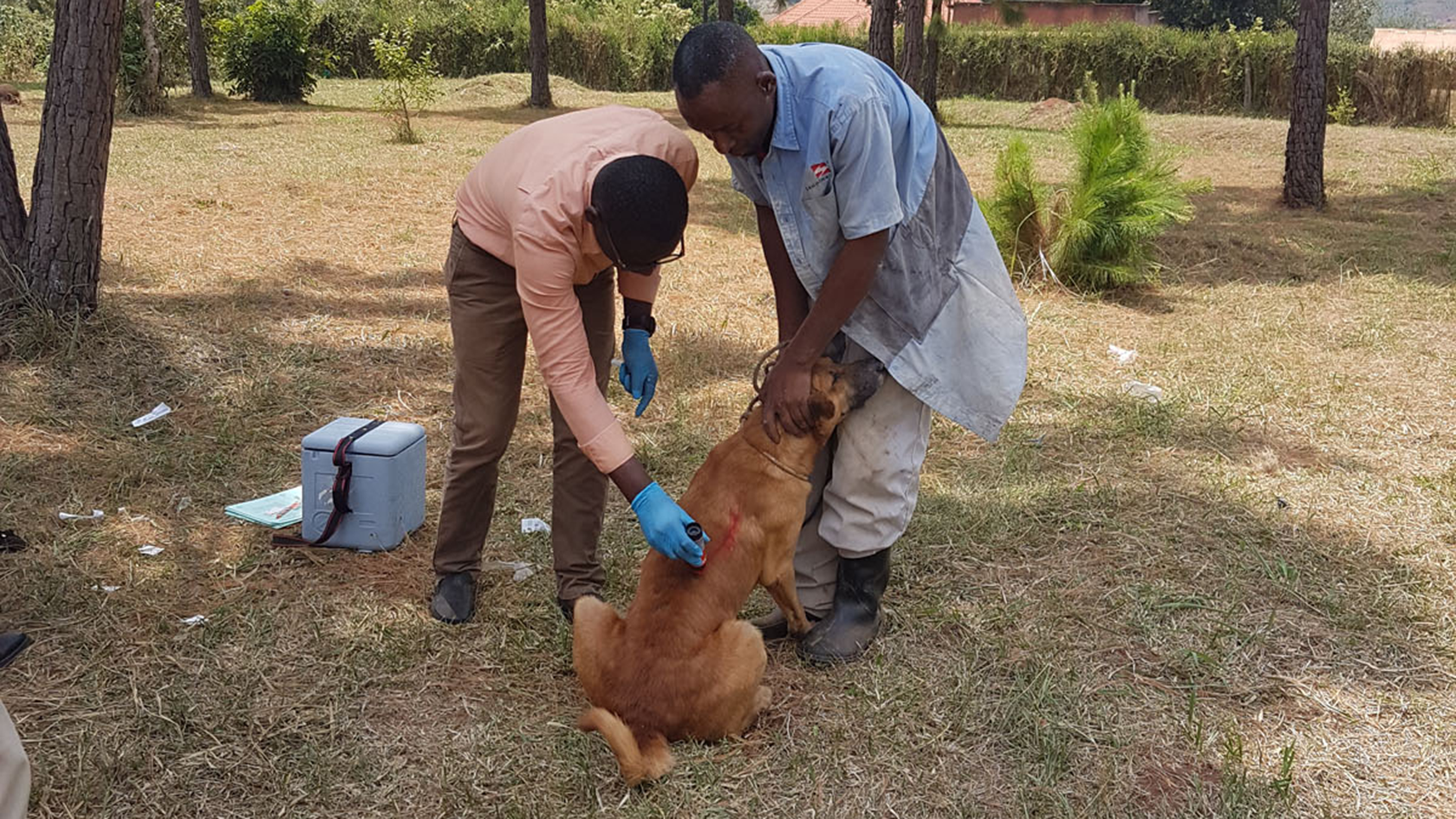Navigation auf uzh.ch
Navigation auf uzh.ch

Around the world, someone dies from rabies every nine minutes of every day. Uganda records over 130 rabies deaths annually, but the number of unreported rabies fatalities there is presumably much higher. Dog bites are the cause of over 95% of all rabies cases. When someone is bitten by a rabid animal, a race against time begins because it’s a death sentence once the virus has reached the brain through neural pathways and the infected person presents the first symptoms. The closer a dog bite wound is to a person’s head, the less time there is to take action.
“To survive, the bite victim must receive a post-exposure prophylaxis (PEP) before the virus reaches neural pathways and the spinal cord,” UZH veterinary epidemiologist Sonja Hartnack explains. However, that’s easier said than done in Uganda: only 20% of animal bite victims receive all five doses of the necessary PEP regimen. “Frequently, there are not enough PEP medications on hand and the bite victim gets sent to another healthcare center, which sometimes is far away,” says Hartnack, who is investigating the rabies problem onsite in Uganda together with research partners at the country’s Makarere University.
Since rabies is mainly a disease of poverty, not everyone can afford transportation to a healthcare center. Also, those affected sometimes don’t consult a doctor after a dog bite because they don’t know it’s necessary, or they contact a traditional healer who casts out demons. “Children are the most frequent victims of dog bites. There have been tragic isolated cases in which children kept a dog bite incident secret from parents and the entire family ended up falling ill with rabies,” Hartnack relates. If dogs were vaccinated against rabies and their vaccination status were viewable in a registry, that could spare families and the healthcare system from having to undergo and administer PEP treatment. Hartnack says that it would be much cheaper to vaccinate dogs to prevent rabies transmission than it is to treat dog bite victims. At the same time, this would mean less suffering for both dogs and people.
This holistic approach of thinking about and promoting the heath of animals, humans, and the environment interconnectedly is called One Health. “It results not just in better care for people and animals, but also reduces costs,” Hartnack says. She is working on a One Health research project dubbed “eRabies” in collaboration with the College of Veterinary Medicine, Animal Resources and Biosecurity (CoVAB) at UZH partner institution Makerere University and in cooperation with the Veterinary Public Health Institute at the University of Bern and the University of Edinburgh and the University of Zurich Travel Clinic. The stated goal of the project is to largely eradicate rabies through vaccination and education campaigns, improved diagnostics, and case surveillance. The project is thus in line with the objectives of the World Health Organization (WHO), which is striving to end human deaths from rabies transmitted by dog bites by 2030.
There are a variety of reasons why the majority of dog owners in Uganda do not get their animals vaccinated. “Some people fear that vaccination lets loose wicked demons in dogs,” Hartnack relates. “Or that it makes watchdogs more timid.” In refugee camps, in contrast, vaccination is often rejected because dogs also serve as food for people.

Some people fear that vaccination lets loose wicked demons in dogs.
As part of the eRabies project, researchers are trialing four different vaccination campaigns to find out how to motivate dog owners most effectively to vaccinate their animals. At the same time, CoVAB veterinarian Samuel Okech is working together with school boards and teachers in the two study sites Kyegegwa and Soroti: the objective is to give students classroom instruction on better ways to look after and handle dogs. Students practice proper behavior to keep from getting bitten, and teachers make responsible dog ownership a subject of classroom discussion. Alongside sheltering and feeding a dog, this also includes basic veterinary care such as vaccination.
In only 8% of bite incidents is it known whether the offending dog was previously vaccinated against rabies. This makes it difficult for doctors to gauge whether a bite victim needs PEP treatment because, on one hand, PEP entails high costs for the family involved, and on the other hand, doctors would like to conserve the scarce PEP medications for those patients who truly need them. To ensure, as far as possible, that life-saving PEP is administered only in actual rabies cases, doctors have to know whether the dog was really infected because oftentimes bite attacks are incited by other reasons: when a dog has been angered, for instance, or when a mother dog is protecting her puppies. “Moreover, some owners give their watchdogs opium to make them more aggressive, and stray dogs are poisoned with strychnine,” Hartnack says. “Both active substances cause cramping that can be mistaken for rabies.”
A biopsy of the animal’s brain tissue is the only way to ascertain with absolute certainty whether a dog carries the rabies virus. However, villagers or dog owners often slay canines after a bite incident. “Owners could send the dog’s head to a laboratory for a biopsy, but they fear that sending a decapitated dog’s head might get them accused of engaging in witchcraft,” Hartnack says. Together with a PhD student, Hartnack is working on solving the unconventional delivery problem and is additionally searching for alternative ways to test dogs for rabies in the field.
A decision-making tool for medical staff is also provided by an app called REACT developed by the nonprofit organization Mission Rabies. This electronic case management system for bite incidents collects information on all material circumstances surrounding the incident and enables a dialogue between veterinarians and human medical doctors because bite victims often get in touch with vets first.
In addition to her research work, a lot of Hartnack’s energy goes into establishing contacts that make new collaborations between Switzerland and Uganda possible. A new joint project in Queen Elizabeth National Park supported by the UZH Global Strategy and Partnerships Funding Scheme came about this way. Its objective is to analyze rabies viruses in wildlife, domestic animals, and humans with the assistance of a laboratory technician specially trained for this purpose and a master’s student. The project enables researchers to investigate how different virus strains spread.
It is very important to Hartnack that science yields benefits for both sides and supports the education of Ugandans. “The average age in Uganda is around 15 – there are a lot of talented young people,” the veterinarian says. In the past, Western researchers and pharmaceutical companies helped themselves too frequently to interesting specimens in the country with no benefit for Uganda itself. “It takes a lot of sensitivity to deal with post-colonialism,” Hartnack says.
In her everyday work, she follows the 11 principles of fair cooperation drafted by the Commission for Research Partnerships with Developing Countries. Responsible research in emerging and developing countries is based on a reflective attitude toward indigenous people, Hartnack explains. “We are colleagues joining forces to improve the situation.”